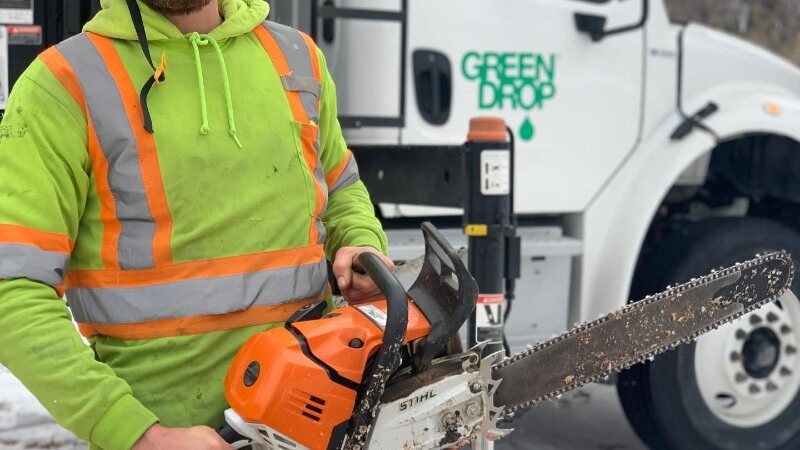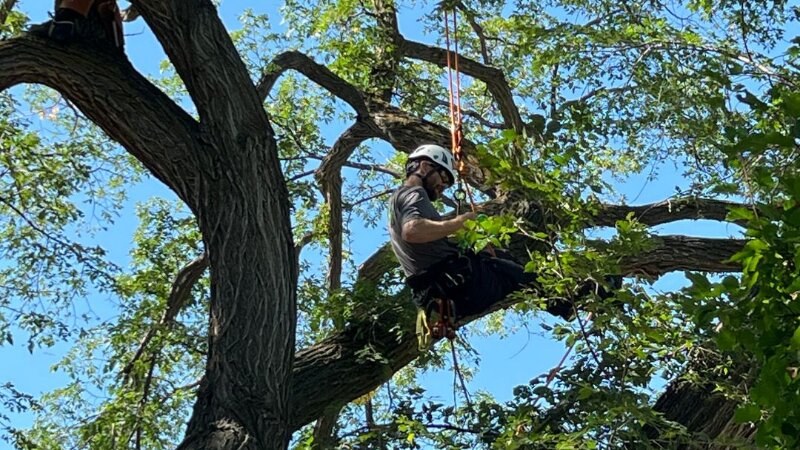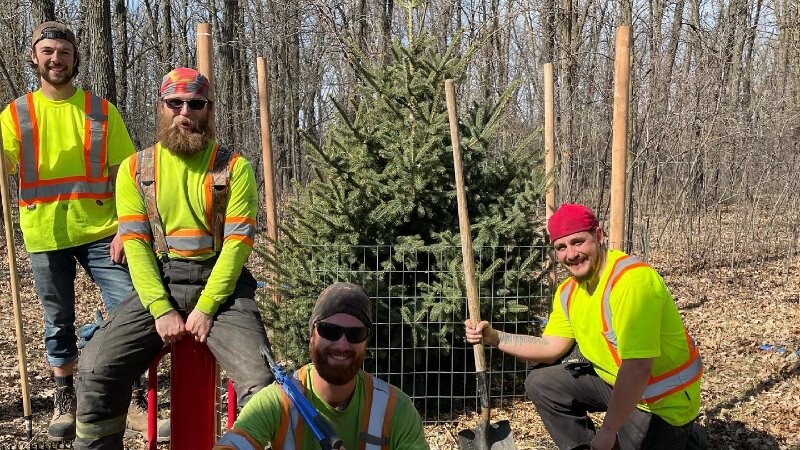Tree Topping vs. Crown Reduction: Our Alberta Arborist Weighs In
Reading time: 6 minutesLarge, towering trees are not only beautiful but an important part of the ecosystem in Western Canada. That said, trees that grow too tall can become a problem. Branches at the top can break during a storm or even uproot if the ground is soggy.
Homeowners generally have two options for overgrown trees: topping or crown reduction.
Learn about tree topping vs. crown reduction below, why the latter is usually better, and what tree services you need when a large tree on your property poses a hazard.

A Review of Tree Topping
Mike Leung, Arboriculture Strategy and Growth Leader at Green Drop Trees, explains, “Tree topping is a harmful practice that involves cutting the top of a tree and large branches indiscriminately to stubs or to lateral branches that are not large enough to assume the terminal role. This effectively reduces the size of the tree but, in doing so, creates several other problems. When a tree has been topped, its entire canopy of foliage is removed, leaving only the bare trunk and the base of the thickest branches.”
Topping is rarely chosen over crown reduction; however, an arborist may recommend having your tree topped if there’s severe storm damage, the tree canopy is mostly gone anyway, or the tree is at an extreme risk of falling.
Utilizing good prevention strategies is key to avoiding future topping, like planting trees where they will have plenty of room to grow and regularly pruning them.
Problems With Tree Topping
Unfortunately, there are many problems related to improper cutting, many of which only serve to make a bad situation worse, like:
- Causing the tree structure to become unsafe. It can be difficult to predict how a tree will hold up under its own weight after topping. For example, removing too many branches on one side can cause the tree to lean and potentially uproot.
- Introducing new fungus or bacteria. Making large cuts across multiple areas of the tree can quickly introduce fungus, bacteria, and other pathogens that put the tree's health at significant risk, even when working with sanitized tools.
- Making trees susceptible to sunscald. A tree’s canopy protects it from sunscald, an unsightly condition caused by the freezing of bark during the winter, followed by sunshine or warm temperatures. This results in the bark dying and falling off, causing bare patches on the trunk of the tree.
- Reducing the value of your property. Topped trees are unsightly and can drastically lower the resale value of your property until their crowns grow back.
- Causing the death of the tree. Worst case scenario, a topped tree can no longer survive and must eventually be cut down to its stump.
Tree topping is also expensive and leaves you with a lot of extra wood that needs to be used or properly disposed of.
Go in-depth on tree topping with Green Drop here.
Crown Reduction Explained
Mike further states, “Crown reduction is a type of tree pruning that reduces the size of a large tree without negatively impacting the structure of the tree's crown. This technique involves pruning back the branches to lateral branches of sufficient size to assume the terminal role.” Bulk and weight are removed from the top of the tree to improve aesthetics and reduce the risk of falling without changing the tree's inherent shape or impeding its growth.
Crown reduction is different from crown raising and crown thinning. Crown raising involves removing lower branches so a tree's foliage starts higher up. In contrast, crown thinning removes small or spindly branches throughout a tree's canopy to increase the space between branches and leaves.
Reducing the crown of a tree involves careful planning and cutting, which typically takes longer than topping a tree. This technique calls for trimming twigs and tree limbs on the upper and outermost parts of the tree, but only to the next lateral growth. This is what keeps them from growing back improperly and ensures speedy healing.
The results are usually well worth it, and homeowners can keep their trees healthy without removing their beautiful, oxygen-producing foliage.

Why Crown Reduction Is Best In Most Cases
There are several reasons why crown reduction is preferred over tree topping for overgrown limbs and foliage, including:
It Puts Less Stress on Trees
Cutting a tree in any way causes stress, but it's important to note that the amount of stress caused is directly proportional to the amount of cutting done. Tree topping involves making drastic cuts to the majority of the tree, removing the entire crown, and causing the tree to sustain significant shock. Even healthy trees may struggle to recover from such widespread and serious damage, potentially resulting in higher susceptibility to disease, stunted growth, and other critical issues.
Crown reduction involves making much smaller cuts throughout the entire top of the tree, removing as little plant material as possible to achieve the desired goal of growth restriction or weight reduction. By making fewer cuts and leaving more healthy branches intact, trees are less stressed by the process and have a much better chance of recovery without serious or long-lasting complications.
It Prevents Regrowth Problems
Tree topping may immediately reduce a tree's size and growth, but it also triggers awkward regrowth. New branches are spindly and vertical, shooting off thick stumps and essentially permanently disfiguring the tree. This doesn't happen with crown reduction. Instead, branches continue to grow normally, keeping the tree from taking on an unattractive look.
Generally, our professional arborists recommend that 25% or less of a tree's total canopy should be removed at one time to prevent the tree from going into shock and to deter water spout growth. That means crown reduction may need to be done more frequently.
It Preserves a Tree’s Aesthetics
Because crown reduction doesn't involve cutting off large portions of the tops of your trees, it helps preserve their beautiful look and improves your home's aesthetics. The tree's shape remains mostly, if not completely, intact, with fewer dead or dying outer branches. This creates a clean, beautiful appearance that boosts curb appeal instead of creating an eyesore.
It Reduces the Chance of Breakage
Top-heavy trees are extremely prone to breakage, especially during winters when snow and ice can accumulate on branches and weigh them down even more. During the crown reduction process, your arborist will also remove dead branches that may break in a storm. This can give you peace of mind that your trees aren’t posing a hazard to you, your family, or your property.
It Improves the Health of Fruit Trees
If you have fruit trees, crown reduction is particularly beneficial for these varieties. With too many branches, blossoms and fruits will begin to compete with one another for water and nutrients to grow. Over time, fruits will become smaller and less flavorful.
Crown reduction, pruning, and trimming practices eliminate this problem and help trees produce larger, riper fruit more consistently. Topping these trees is especially bad since new shoots cannot bear fruit and will generally only develop leaves.

Got Trees? Green Drop Can Help With All Your Tree Pruning Needs
We have a team of ISA-certified tree arborists standing by to provide tree pruning and tree trimming services in Calgary, Edmonton, and Red Deer.
We also serve surrounding areas in Western Canada, specifically Regina, Saskatoon, and Winnipeg.

